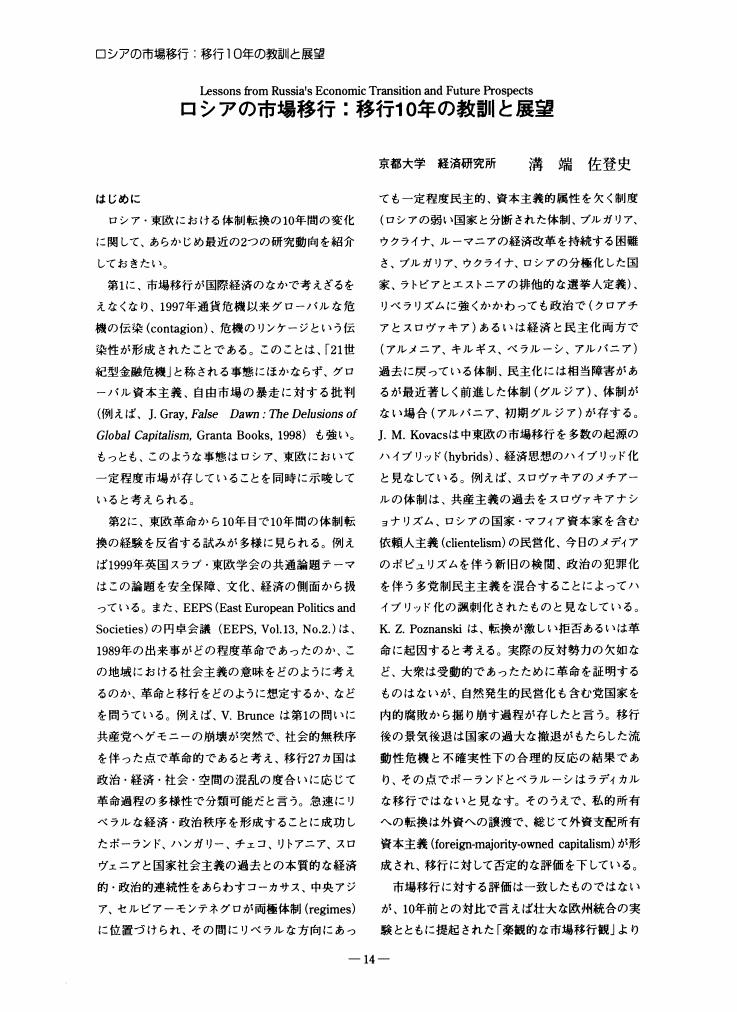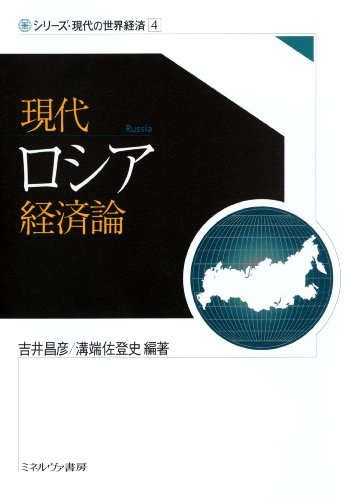9 0 0 0 OA ロシアにおける国家資本主義(<特集>市場移行国における「国家資本主義」をめぐって)
- 著者
- 溝端 佐登史
- 出版者
- 経済理論学会
- 雑誌
- 季刊経済理論 (ISSN:18825184)
- 巻号頁・発行日
- vol.52, no.2, pp.16-30, 2015-07-20 (Released:2017-07-03)
This paper analyses state capitalism in Russia from the viewpoint of state capital and state functions. As far as the Russia's government size (number of public servants and financial expenditures of the public sector) equals to those in developed countries, it cannot be applied as a precise indicator to characterize state capitalism. On the other side, both the state capital as a market player and the state functions can be regarded as qualitative characteristics of the Russian capitalism. As for the state capital, both privatization and state intervention have coexisted, and have simultaneously functioned for "controlling the highlands (the mainstay of state)". Moreover, the 2008 global economic crisis authorized state intervention. In order to maintain global competitiveness, the government has established strategic enterprises and has implemented preferential measures. Even though the state sector in the economy has decreased, it has enhanced its intervention into the private sector of the economy. The state has a strong influence on the economy via holding shares and regulations. Particularly, state-owned enterprises have changed their enterprise type from state corporations and unitary enterprises to joint-stock companies. In addition, "the exchange system of interests (state capture and business capture)" has been established and the state capital has openly showed its new "internationalization" behavior. The state capital has close ties with the global financial flows and it has stipulated the emergence of Russia's multinationals that are deeply connected with tax havens. Despite the offshore problem, the state sector is deeply linked with the global network and, therefore, state capitalism cannot exist without linkages with the global market. With regards to authoritarian political regime, concentration of powers, and existence of oil and gas rents, Russia is none other than state capitalism. However, functions and quality (good governance) of the state capitalism are far behind other developed countries. The Russian state is inferior in terms of state functions and state quality; the state as a coordinator of interests by grabbing hands may not be regarded as a strong one. Thus, Russia (Putin's regime) cannot be referred as "a normal middle income democratic country". Finally, low quality and authoritarian regime are mutually complementary in Russia, and the legacy inherited from the past also aff ected institutionalization of low quality state and institutional complementarities. State capitalism has also balanced interests among players. Why has state capitalism spread into the emerging and transition economies? The state sector has become a tool to correct the distorted markets. The basis of the Russian state capitalism is its global linkages with global markets (WTO accession), low-quality state coordination of oligarchs' behavior, and premature financial markets. This state intervention is old style, but it is a new phenomenon from the viewpoint of global adaptation. Global trends are common among other transition economies. However, the Russian case is based on its own historical and social thought. Thus, being both "old" and "new," Russian state capitalism seems resilient.
5 0 0 0 OA 移行経済諸国の倫理破綻と汚職行動 ―体系的レビュー―
- 著者
- 鈴木 拓 溝端 佐登史
- 出版者
- 比較経済体制学会
- 雑誌
- 比較経済研究 (ISSN:18805647)
- 巻号頁・発行日
- vol.55, no.1, pp.1_23-1_43, 2018 (Released:2018-02-22)
- 参考文献数
- 96
市場経済移行研究では汚職問題は早期から注目されていたが,その分析視点は発散傾向にある.そこで本稿では331件の文献に基づき,政治・経済的要因及び文化・価値観といった観点から14の仮説検証を通じて体系的レビューを行う.その結果,自由化・私有化は汚職に拡大と縮小の両義的な影響を与えており,かつ文化・価値観の影響も無視できないこと,そしていわゆる“潤滑油仮説”はほぼ否定されていることが明らかになった.
2 0 0 0 OA ソ連における所有形態・企業形態の改革―株式化を通して―
- 著者
- 溝端 佐登史
- 出版者
- 比較経済体制学会
- 雑誌
- 社会主義経済学会会報 (ISSN:18839789)
- 巻号頁・発行日
- vol.1991, no.28, pp.14-22, 1991-03-20 (Released:2009-07-31)
2 0 0 0 OA 漂流する世界と研究の意義
- 著者
- 溝端 佐登史
- 出版者
- ロシア・東欧学会
- 雑誌
- ロシア・東欧研究 (ISSN:13486497)
- 巻号頁・発行日
- vol.2016, no.45, pp.1-2, 2016 (Released:2018-06-02)
1 0 0 0 OA 大不況・大後退と教育研究の貧困化
- 著者
- 溝端 佐登史
- 出版者
- ロシア・東欧学会
- 雑誌
- ロシア・東欧研究 (ISSN:13486497)
- 巻号頁・発行日
- vol.2017, no.46, pp.1-4, 2017 (Released:2019-02-01)
- 著者
- 溝端 佐登史
- 出版者
- ロシア・東欧学会
- 雑誌
- ロシア・東欧研究 (ISSN:13486497)
- 巻号頁・発行日
- vol.2016, no.45, pp.191-194, 2016 (Released:2018-06-02)
1 0 0 0 OA 世界経済の変動とソ連・ロシア経済
- 著者
- 溝端 佐登史
- 出版者
- ロシア・東欧学会
- 雑誌
- ロシア・東欧研究 (ISSN:13486497)
- 巻号頁・発行日
- vol.2015, no.44, pp.29-43, 2015 (Released:2017-08-18)
- 参考文献数
- 38
The present study demonstrates theoretical significance of system changes in the Soviet/Russian economy under the globalization, and reexamines its research changes. Through the historical evolution and the research development, rich experiences in the Soviet/Russia give us basis for an investigation of the economic system, particularly market and the state. Russia radically liberalized in transition and its liberalization process synchronized neo-liberal changes of the world after 1970s, which made the contemporary capitalism “normalized” one with the unequal society. In practice, Russia drastically changed its economic system after the transformation in 1992, and a newly built market looked to function completely, based on the liberal economic institutions. The Russian market, however, has shown its specificities strikingly different from the standard model of the developed market. The concepts such as “the emerging market” and “the state capitalism” also testify that Russia has different market structure and different market actors. The Soviet/Russian economy has fluctuated on “the imported growth model” by petroleum and cheap money as well as an economic cycle, which were caused by a long-term Soviet/Russian structure. Economics of transition in Russia gives clues to analyze the fundamental determinants in the Soviet/Russian economic crisis. The following determinants work in close operation. First of all, in spite of liberal policy measures, the economic growth cannot establish normal markets and cannot improve market quality. Market quality can be defined as a measure of efficiency in allocation and fairness in pricing based on market infrastructure. The Russian market building caused misuse of institutions and rules and it lost the law enforcement. The informal institutions substituted for the formal institutions, and even though they diminished risks and transaction costs under a malfunction of market infrastructure, market quality has got worsened. The state’s strong control over the economic actors also accelerated deterioration of market quality. Secondly, under the strong ideology of neoliberalism, the state excessively retreated from the economy in transition. The state lost the fundamental capability and reliable policy making, and state quality also deteriorated. While the rentier state expanded tax revenues and state assets with a favorable oil price, Russia could not build the efficient tax state. Tax haven and offshore have broken the normal financial flow. The state institutions destabilized and the state changed into the authoritarian regime. Both market and state quality have become risk factors. The evolution of markets and state are based on geopolitics, international environments, and endogenous socio-economic conditions. The institutional evolution certifies the above market and state barriers. On the one hand, institutions liberalized based on the global standards. On the other hand, the institutions that emerged from the transition did not converge into the “normal”, and follow a path the Soviet/Russia have shaped. The cultural inertia and legacies as a relationship become a determinant of institutional arrangement, and institutions change in ‘path-dependent’ ways. The view on the institutional change certifies continuous evolution of institutions in the Soviet/Russia and difficulties for improving quality of market and state under the politicized regime.
1 0 0 0 OA 存在感のあるロシア・東欧学会をめざして
- 著者
- 溝端 佐登史
- 出版者
- ロシア・東欧学会
- 雑誌
- ロシア・東欧研究 (ISSN:13486497)
- 巻号頁・発行日
- vol.2015, no.44, pp.1-3, 2015 (Released:2017-08-18)
1 0 0 0 OA ロシアにおける経済格差
- 著者
- 溝端 佐登史
- 出版者
- ロシア・東欧学会
- 雑誌
- ロシア・東欧研究 (ISSN:13486497)
- 巻号頁・発行日
- vol.2003, no.32, pp.3-18, 2003 (Released:2010-05-31)
- 参考文献数
- 40
After the Russian financial crisis of 1998 issues such as the sustainability of economic growth, economic inequality and poverty have become points of contention both in Russia and in the world. The main purpose of this paper is to investigate economic disparity and inequality and their influence over market transition in Russia, and to consider how people behave under conditions of economic inequality.First of all, globalisation and the market transition in Russia has brought about increased international disparity. As a result of the investment gap, the real disparity in economic power is greater than it seems. At the same time, domestic economic disparities in Russia have expanded during market transition. There is a striking contrast among industries. There are growing sectors like exports, resources and energy, average sectors and stagnating sectors such as light industry and machine assembly. Equipment age structure and investment capacity also gives an account of industrial disparities. In addition, regional differentiation is striking with Russia's economy often referred to as “one metropolis capitalism”. We can observe an increase in regional disparities in unemployment rate and in the share of loss-making enterprises, which suggest different levels of adaptability to the market.Is Russia egalitarian in relation to income and assets? Considering the Gini coef-ficient, inequality increased in Russia during the transition process. It is important to appreciate that changes in inequality were very large and occurred during the early years of transition. Income and expenditure of households indicate such changes. Revenue from business activities and property income are increasing, while wage differentials have maintained their influence. Among expenditures, the share of savings is increasing. Consumption differentiation can be observed among non-basic goods like consumer durables. These phenomena suggest the existence of a segmented market. The redistribution effects of social transfer, however, have been preserved and we cannot neglect them under the flat income tax system. Thus, empirical evidence suggests heightened inequality and social stratification has accompanied government failure.However, the population of Russia has not always reacted destructively regarding inequality and poverty. The nature of industrial disputes also suggests weak resistance and low levels of dissatisfaction. First, economic inequality has led to the exit of losers who have sought additional revenue in the informal sector. Second, families have enlarged their economic activity, which compensates for income shortages. Third, there is a gray area between the official labour market and unemployment. According to the new investigation, the informal employment includes more than 15% workers. Fourth, elasticity of wages is strong and stimulates the second job. Finally, Russian enterprises have kept their social function in the transition period. The above re-sponses are based on the legacy of the former system and they have the twofold effect of both easing and intensifying inequality. Economic inequality and the specific reactions to it to a large extent reflect the peculiarities of the Russian market.
1 0 0 0 OA ロシアの市場移行: 移行10年の教訓と展望
- 著者
- 溝端 佐登史
- 出版者
- ロシア・東欧学会
- 雑誌
- ロシア・東欧学会年報 (ISSN:21854645)
- 巻号頁・発行日
- vol.1999, no.28, pp.14-28, 1999 (Released:2010-05-31)
- 参考文献数
- 14
1 0 0 0 OA ロシアにおける社会・経済構造の変化と経済政策の選択
- 著者
- 溝端 佐登史
- 出版者
- ロシア・東欧学会
- 雑誌
- ロシア・東欧学会年報 (ISSN:21854645)
- 巻号頁・発行日
- vol.1996, no.25, pp.31-47, 1996 (Released:2010-05-31)
- 参考文献数
- 6
1 0 0 0 OA ロシアにおける市場経済化と経営者形成の現段階
- 著者
- 溝端 佐登史
- 出版者
- ロシア・東欧学会
- 雑誌
- ロシア・東欧学会年報 (ISSN:21854645)
- 巻号頁・発行日
- vol.1993, no.22, pp.1-14, 1993 (Released:2010-05-31)
- 参考文献数
- 22
1 0 0 0 OA 現代ソ連における中小企業の機能
- 著者
- 溝端 佐登史
- 出版者
- 比較経済体制学会
- 雑誌
- 社会主義経済学会会報 (ISSN:18839789)
- 巻号頁・発行日
- vol.1985, no.22, pp.5-7, 1985-01-10 (Released:2009-07-31)
1 0 0 0 OA ロシアにおける産業政策と資本再編
- 著者
- 溝端 佐登史
- 出版者
- 比較経済体制学会
- 雑誌
- 比較経済体制学会会報 (ISSN:18839797)
- 巻号頁・発行日
- vol.36, no.1, pp.14-24, 1999-03-01 (Released:2009-12-03)
- 参考文献数
- 16
1 0 0 0 OA ロシアの経済政策と市場化の現状
- 著者
- 溝端 佐登史
- 出版者
- 比較経済体制学会
- 雑誌
- 比較経済体制学会会報 (ISSN:18839797)
- 巻号頁・発行日
- vol.1995, no.33, pp.8-16, 1995-11-01 (Released:2009-07-31)
1 0 0 0 現代ロシア経済論
- 著者
- 吉井昌彦 溝端佐登史編著
- 出版者
- ミネルヴァ書房
- 巻号頁・発行日
- 2011
1 0 0 0 中央アジア・カザフスタンの環境と経済の再生計画
- 著者
- 塚谷 恒雄 テイラー J.A. ニックス H.A. アルマベコビッチ U.R スルタンガジン U.S. 江崎 光男 今井 賢一 福嶌 義宏 石田 紀郎 溝端 佐登史 TAYLOR J.a. ALMABEKOVICH U.r. スルタンガジン U.M.
- 出版者
- 京都大学
- 雑誌
- 国際学術研究
- 巻号頁・発行日
- 1993
1中緯度乾燥地域の地球規模汚染モデルの作成は,共同研究者であるカザフスタン共和国科学アカデミー宇宙研究所のスタッフによってまとめられた.これは旧ソ連で開発された組込原則による拮抗モデルを非平衡環境システムに応用したもので,アルマ-ティにおいてまずロシア語版で出版された.またバルハシ湖周辺を対照とした水文気象観測データを用いGISの構築にも基礎的結果を得た.バルハシ湖とアラル海の水質分析結果の公開はおそらく世界で初めてであろう.これは国際砂漠学会で発表され,以降各国学界から注目されている.またバルハシ湖については本分析結果を1960年代初頭のデータと比較し,乾燥地閉鎖湖の除塩機構に関し地球化学的変化の一端を示すことができた.2環境汚染による健康被害の疫学的調査は,カザフスタン側共同研究者の尽力によって,アラル海とシルダリア川沿岸の乾燥地域,アルマ-ティの工業地域およびセミパラチンスクの各実験地域について,おそらく世界最初に詳細な健康影響データが公表された.国際的な共感を呼んでいるアラルの悲劇はこの地方全体の文明,社会経済指標および住民の健康状態に重大な影響を与え,免疫ホメオスターシスの脱抑制,免疫病理反応を進行させている.B型ウイルス性肝炎の住民感染率は32.7%,HBs抗原の慢性キャリア率は19.1%にも達している.冷戦の遺産セミパラチンスク核実験場の周辺住民は,40年の長きにわたって合計50ラドから200ラドの放射線被爆を蒙った.放射線に起因する免疫変化は,腫瘍疾患,血液疾患,先天性異常,心・血管系疾患,感染症,その他の病理を含む一般罹患率の上昇を導いた.疾患分布と被爆線量との間には有意な相関関係が見いだされ,腫瘍疾患の増加には罹患率と死亡率上昇の位相性が認められた.この結果は日本文でKIERディスカッションペ-パ-にまとめられた.3セミパラチンスク核実験場の放射能評価は,カザフスタン側共同研究者の尽力によって国立核センターの協力のもとで進められた.まず昨年度採取したシャガン川人工ダム(1965年1月15日の半地下核実験による)周辺土壌の分析から^<237>Np/^<239,240>Pu比を割り出し,この実験が水素爆発ではなく通常のプルトニウム原爆によることを推測した.この結果を実験担当者等に確認したところ,当該核実験の詳細データの提供を受けた.加えて1949年8月29日から1962年12月1日の間にセミパラチンスク核実験場で行った地上実験(30回)空中実験(88回)の基礎情報の提供を受けた.これは前年度の実験影像の提供と同様,世界で初めて公表されたものであり,日本に対するカザフスタンの信頼が高いことを示している.この結果は英文でKIERディスカッションペ-パ-にまとめられ,国際原子力機関(IAEA)にも送られた.また再生計画に資するため,実験場内部と周辺居住地で土壌,植物,血液の資料採取を行った.ただし膨大な分析時間がかかるため,残念ながら本国際学術研究の期間内に完結することはできなかった.各担当者は早急に成果を取りまとめる努力をしている.4再生アセスメントの設計に関し,率直に言って,新独立国家群の経済再建は困難の極みにある.国民や組織,機関の願望や期待,あるいは欲求を達成できる社会経済システムが未熟であるためである.研究分担者らは学会発表や学術討論など機会あるごとに資源節約型の経済システム構築が中央アジア諸国の命運を決定し,それが環境保全につながることを強調してきた.これを一層推進するためには,科学的情報の受信発信の体制を整備することが急務であると共同研究者間で意見が一致し,本年度は科学アカデミーで蓄積された環境経済関連の成果の整備に取りかかり,合計3,000点の文献目録データベースを完成させた.この結果は英文でKIERディスカッションペ-パ-にまとめられた.この作業で,アラル海とバルハシ湖に関する旧ソ連科学アカデミー湖沼学研究所が地球化学,古生物学,鉱物学などの学際研究を蓄積していることが判明し,その結果は日本文でKIERディスカッションペ-パ-にまとめられた.











